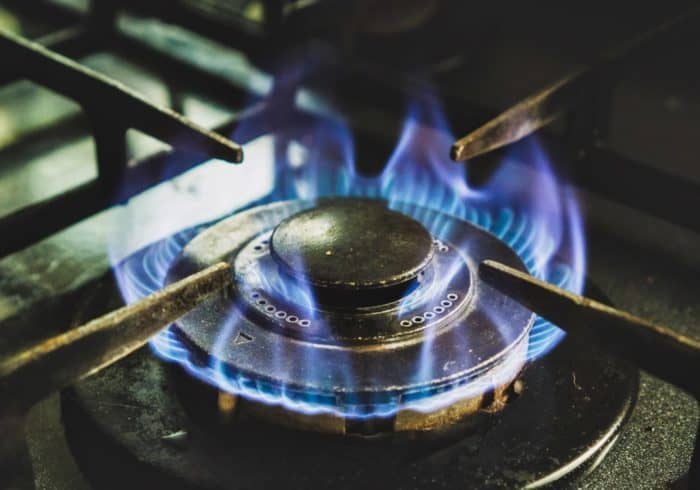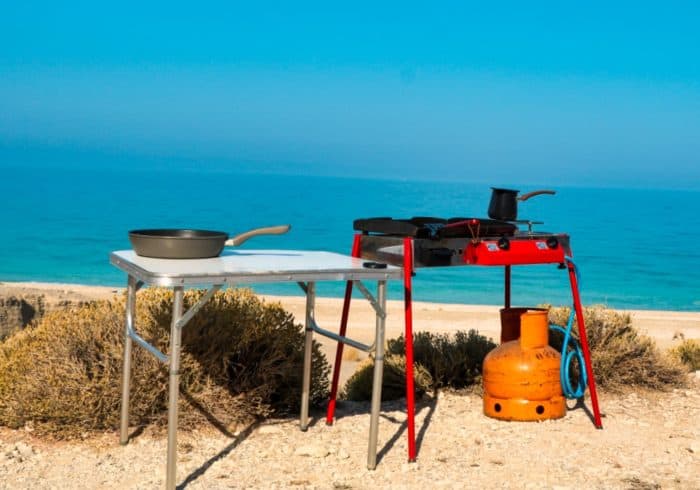Why Do I Need A 2-Stage RV Propane Regulator?
Propane is everywhere. It’s in RVs, homes, industrial buildings, restaurants, basically anywhere there is an LP gas appliance is being used.
Wherever there’s propane, there’s usually a regulator of some sort.
Related Product: Quickly check connections for leaks using the very portable Toptes Gas Leak Detector (click to view on Amazon)
Propane regulators are a necessary part of any propane system. Propane RV appliances require 2 stages of regulators.
The best way to understand how an RV propane regulator works is to first understand what each stage does.
See Also: 7 Signs That Your RV Propane Regulator Has Gone Bad

Stage 1
The first stage regulates the pressure directly from the propane tank.
When the propane tank is far away from the appliance (like a house propane system), the first stage regulator is by the tank and the second stage is closer to the appliance.
In an RV, the propane tanks are closer to the appliances that need them. The first and second stages of the regulators can be together in one unit.
See Also: Propane Tank Recertification: How & Where To Get Recertified
To put it in simpler words, the first stage takes the pressure from the propane tanks down to a manageable level for the second stage of the regulator to do its job.
Usually, it’s 10-15 pounds of pressure.

Stage 2
The second stage of the RV propane regulator takes the smaller amount of pressure provided by the first stage and turns it into the standard propane pressure for appliances in a regulated unchanging stream.
Standard pressure is normally at 11″ on a water column.
You must have both regulators on a propane system in order for it to work. They also need to be a matching set and compatible with each other.
You cannot place the second stage regulator before the first, it must come after.
See Also: Best 2 Stage Dual Adjustable RV Propane Regulators
RV propane regulators are very simple to install and use.
Some aren’t even adjustable because the propane system in an RV is simple and doesn’t need adjustments.
The only thing you really need to watch out for are leaks.
If you need to change your RV propane regulator, there are detailed instructions on how to do it and what you will need here.
Frequently Asked Questions
What are the main components of an RV propane regulator?
The main components of an RV propane regulator are an inlet connection, outlet connection, diaphragm or valve mechanism, and a vent.
Sometimes there will be an adjustment knob, but it’s not very common, especially on campers.
Why is it important to have a properly functioning propane regulator in an RV?
A 2-stage propane regulator is essential for the safe operation of propane appliances in an RV.
It ensures propane is delivered at the correct pressure. This prevents damage to appliances and reducing the risk of leaks.
How can I tell if my RV propane regulator is malfunctioning?
Signs of a malfunctioning RV propane regulator include uneven flame on propane appliances, difficulty lighting appliances, hissing or whistling sounds near the regulator, or a strong odor of propane.
You can also tell by the way any propane fueled RV appliance is working. When a regulator isn’t doing what it should, the fridge might not have enough power to get down to the correct temperatures, the flames on the stove burners will be weak, the water heater won’t heat water very vast.
These are all signs that the RV propane regulator needs to be replaced or adjusted.
What are the common issues with RV propane regulators?
RV propane regulator problems are usually because of diaphragm wear, debris blockage, or pressure adjustment problems.
The diaphragm will eventually go bad no matter what you do. Which means a regulator replacement is inevitable after 5-10 years.
Are there other types of propane regulators, and how do they differ?
Yes, there are various types of propane regulators, including single-stage and two-stage regulators.
Single-stage regulators reduce pressure in one step, while two-stage regulators reduce pressure in two steps, providing a more consistent output pressure.
RV propane regulators are almost always 2 stage.
How often should I inspect and maintain my RV propane regulator?
You should inspect the RV propane regulator annually or before each camping season.
Regular maintenance includes checking for leaks, cleaning the regulator, and ensuring proper operation.
Gas leak detectors like the TopTes PT199 Gas Leak Detector (click to view on Amazon) makes checking for leaks quick and super easy.
Can I replace my RV propane regulator myself, or do I need a professional?
If you are comfortable doing small repairs on an RV, you should be able to replace a regulator on your own.
You can see how to in this article here (click to view)
Have questions about how RV propane regulators work? Leave a comment below.


I bought a used RV that does not have a cook top installed. There is a gas line in the countertop to allow for use of an outdoor camp stove. The pressure is not high enough to operate our outdoor stove (per RV code regulations). If I had an adjustable regulator on the tank, could I just increase the pressure on the tank when I needed to use the stove and back to low when I needed to use the heater?
Also, there is currently a fixed 2 stage regulator on the tank. Do I need a 2 stage regulator? I can’t find an adjustable 2 stage regulator on the market.
Hi Lauren,
The standard propane pressure for an RV should be more than enough to run an outdoor stove. Lots of RVs have propane quick connects on the outside you can use to run an outdoor stove and everything goes through the propane regulator. It sounds like the regulator that is on the RV now might be the problem. You shouldn’t need an adjustable one to get it to work.
I suggest getting a new 2 stage RV propane regulator like this one (click to view on Amazon) if you have two propane tanks. It can output up to 190,000 btu which should be more than enough for any propane stove.
I hope this was helpful, I’m not a professional but that’s what I would do.
Hello. I have an issue that hopefully you can help me with. I have a ’22 Keystone Montana. I am in cold climate, but not in the minus range. Twice in the last 2 weeks I’ve filled an empty tank, yet the regulator has not swung over to take the flow from the full 2nd tank. Now I have 2 full 10-gallon tanks, but the regulator is stuck on “E” and, obviously, I have to propane flow to the ignitor. The last time this happened, it finally showed green and began working again after a few turns of the tank switch, but this time, nothing happens on either of the 2 full tanks. Any suggestions?
Thanks
Hi Richard,
You may need to reset your propane regulator by turning off the propane tanks and draining the rv fuel lines.
Then wait for a few minutes before slowly opening the valves to the propane tanks.
If that doesn’t work the regulator could be broken somehow. I know the automatic changeover regulators have given me issues in the past.
The last time I had an issue I had to replace the regulator.